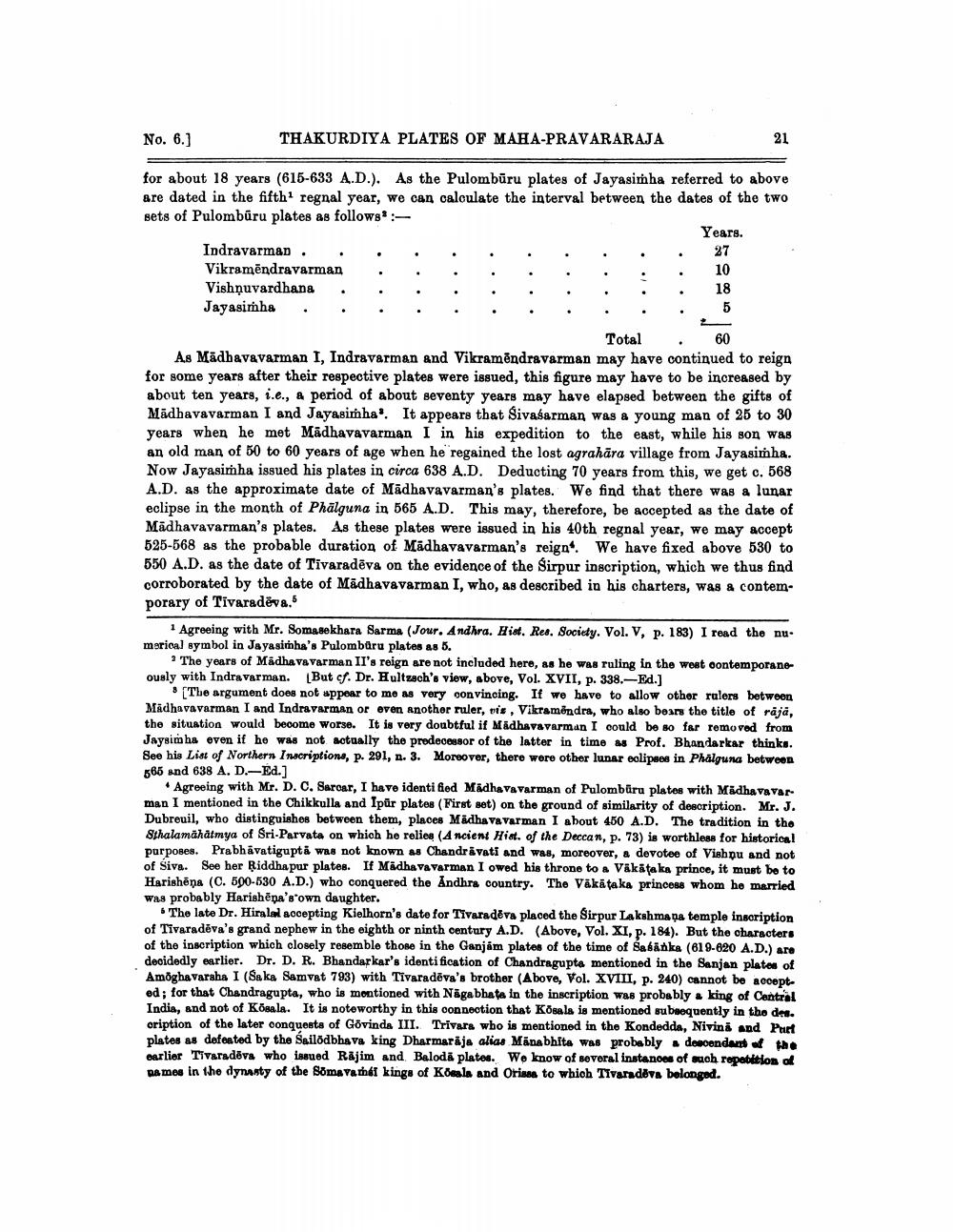________________
THAKURDIYA PLATES OF MAHA-PRAVARARAJA
No. 6.]
for about 18 years (615-633 A.D.). As the Pulombūru plates of Jayasimha referred to above are dated in the fifth1 regnal year, we can calculate the interval between the dates of the two sets of Pulomburu plates as follows:
Indravarman . Vikramendravarman Vishnuvardhana Jayasimha
Years.
27
10
18
21
5
Total
60
As Madhavavarman I, Indravarman and Vikramendravarman may have continued to reign for some years after their respective plates were issued, this figure may have to be increased by about ten years, i.e., a period of about seventy years may have elapsed between the gifts of Madhavavarman I and Jayasimha. It appears that Sivaśarman was a young man of 25 to 30 years when he met Madhavavarman I in his expedition to the east, while his son was an old man of 50 to 60 years of age when he regained the lost agrahara village from Jayasimha. Now Jayasimha issued his plates in circa 638 A.D. Deducting 70 years from this, we get c. 568 A.D. as the approximate date of Madhavavarman's plates. We find that there was a lunar eclipse in the month of Phalguna in 565 A.D. This may, therefore, be accepted as the date of Madhavavarman's plates. As these plates were issued in his 40th regnal year, we may accept 525-568 as the probable duration of Madhavavarman's reign. We have fixed above 530 to 550 A.D. as the date of Tivaradeva on the evidence of the Sirpur inscription, which we thus find corroborated by the date of Madhavavarman I, who, as described in his charters, was a contemporary of Tivaradeva.5
1 Agreeing with Mr. Somasekhara Sarma (Jour. Andhra. Hist. Res. Society. Vol. V, p. 183) I read the nu merical symbol in Jayasimha's Pulombaru plates as 5.
2 The years of Madhavavarman II's reign are not included here, as he was ruling in the west contemporaneously with Indravarman. [But cf. Dr. Hultzsch's view, above, Vol. XVII, p. 338.-Ed.]
[The argument does not appear to me as very convincing. If we have to allow other rulers between Madhavavarman I and Indravarman or even another ruler, vis, Vikramendra, who also bears the title of räjä, the situation would become worse. It is very doubtful if Madhavavarman I could be so far removed from Jaysimha even if he was not actually the predecessor of the latter in time as Prof. Bhandarkar thinks. See his List of Northern Inscriptions, p. 291, n. 3. Moreover, there were other lunar eclipses in Phalguna between 565 and 638 A. D.-Ed.]
Agreeing with Mr. D. C. Sarcar, I have identified Madhava varman of Pulomburu plates with Madhavavarman I mentioned in the Chikkulla and Ipur plates (First set) on the ground of similarity of description. Mr. J. Dubreuil, who distinguishes between them, places Madhavavarman I about 450 A.D. The tradition in the Sthalamähätmya of Sri-Parvata on which he relies (Ancient Hist. of the Deccan, p. 73) is worthless for historical purposes. Prabhavatigupta was not known as Chandravati and was, moreover, a devotee of Vishnu and not of Siva. See her Riddhapur plates. If Madhavavarman I owed his throne to a Väkätaka prince, it must be to Harishēna (C. 590-530 A.D.) who conquered the Andhra country. The Väkätaka princess whom he married was probably Harishēņa's own daughter.
The late Dr. Hiralal accepting Kielhorn's date for Tivaradeva placed the Sirpur Lakshmana temple inscription of Tivaradeva's grand nephew in the eighth or ninth century A.D. (Above, Vol. XI, p. 184). But the characters of the inscription which closely resemble those in the Ganjam plates of the time of Sasanka (619-620 A.D.) are decidedly earlier. Dr. D. R. Bhandarkar's identification of Chandragupta mentioned in the Sanjan plates of Amoghavaraha I (Saka Samvat 793) with Tivaradeva's brother (Above, Vol. XVIII, p. 240) cannot be accepted; for that Chandragupta, who is mentioned with Nagabhata in the inscription was probably a king of Central India, and not of Kosala. It is noteworthy in this connection that Kösala is mentioned subsequently in the des. cription of the later conquests of Govinda III. Trivara who is mentioned in the Kondedda, Nivina and Purt plates as defeated by the Sailōdbhava king Dharmaraja alias Manabhita was probably a descendant of the earlier Tivaradeva who issued Räjim and Balodā plates. We know of several instances of such repetition of names in the dynasty of the Somavathét kings of Kösals and Orissa to which Tivaradeva belonged.




